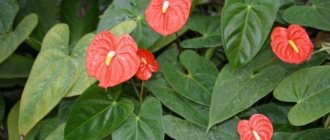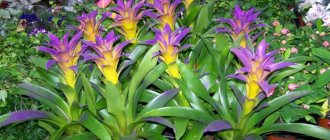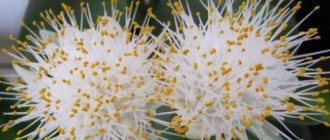Callas belong to the Araceae family. This plant is a perennial, grows in coastal and swampy areas, on the continents of Eurasia, North America and Africa, where a temperate and subtropical climate prevails.
For a flower, calla lilies have an unusual appearance, the stem length is about 80 cm. But this is not the limit, there are also taller varieties. The root system of the calliper is hollow rhizomes with shoots, the total length of which is from 60 to 90 cm. Bright green large leaves reach 30 cm in length, located near the rhizome. They are used in folk medicine as an anti-inflammatory agent.
Flowers similar to Calla lilies
There are two plants incredibly similar to Calla lilies - Spathiphyllum and Anthurium. They are just as beautiful and undoubtedly deserve attention.
Anthurium fire element. It blazes along with the red Calla, Spathiphyllium - “Snow White”. Its flower, as if descended from the mountain peaks, can boldly resist the whiteness of the bride’s dress.
All these plants (including Callas) belong to the Araceae genus. They arrived at the house of a man from the tropics: South America, Argentina, Paraguay and Mexico.
Male and female happiness
“Male and female happiness” is one continuation of the other . Two beautiful flowers are similar in their origin, appearance, and most importantly - symbolic meaning.
When located next to each other, Spathifillium and Anthurium represent a unique and perfect harmony. All fans of Calla lilies will undoubtedly like these flowers: they are so similar.
If a gift is to be given, then Spathiphyllum is presented to women, and Anthurium - to men. These flowers can be given not only in pots . Florists often use Spathiphyllum and Anthurium in bouquets. They retain their freshness for a long time - 20 days or more.
Description of plants similar to calla lilies
In indoor floriculture, there are several types of plants similar to calla lilies.
Spathiphyllum
Spathiphyllum also belongs to the Araceae family. Depending on the variety, it grows from 50 to 150 centimeters in height. Its bright green or variegated foliage is collected in a basal tuft. It has an ovoid shape, in some varieties its structure resembles corrugation. The length ranges from 25 to 90 centimeters, and the width from 10 to 40 centimeters. A spathiphyllum flower consists of a yellow or greenish-colored spadix and a spathe.
Unlike calla lilies, the spathiphyllum cover has an oval shape and is located vertically. By the end of flowering, its white color turns greenish.
Anthurium
Anthurium is an evergreen plant belonging to the Araceae. It can reach more than a meter in height. Anthurium has shiny, tough, solid foliage of a dark green color. It is heart-shaped and up to 40 centimeters long. The flower spadix may be white, pink or yellow.
Unlike calla lilies, the bract, like the leaves of the plant, is heart-shaped and is located around the cob, perpendicular to it.
The blanket can be white, salmon, pink or purple. But, for some reason, today varieties that have only red flowers are most often grown. People often call them “tongues of fire”, “flamingo flowers” or “men’s happiness”. It is believed that anthurium gives a man strength and brings happiness and good luck to his home.
Zantedeschia
Zantedeschia, like callas, is a perennial flowering plant belonging to the Araceae. Its underground part can be either a rhizome or a bulb. Depending on the type, its bushes can produce stems from 50 centimeters to 1 meter in height.
The foliage of the plant is bright green in color and heart-shaped. The appearance of the flower resembles a calla lily. It consists of a yellow cob and, depending on the varietal variety, can be white, pink, greenish, yellow, cream with a lemon tint, lilac-cherry, dark purple.
Whitewing
Calla palustris is a member of the evergreen perennials of the Araceae family. It is a small compact plant about 30 centimeters tall. Its heart-shaped green foliage in some varietal specimens may be covered with white or yellowish spots. They have a length from 6 to 14 centimeters and a width from 5 to 11 centimeters. The ear of the calla lily, like that of calla lilies, is yellow in color. The inside of the bedspread is painted white, and the outside is greenish.
There are not many indoor flowers that look like calla lilies. But, in addition to the fact that they belong to the same family and have some visible similarities, they also have a number of clearly visible differences, for example, in the shape of foliage and bedspread. Therefore, having studied the features of their structure, you can easily determine their name. This will help determine their further content, which will contribute to the proper development and abundant flowering of plants.
Popular types
Thanks to the hard work of botanists in breeding this plant, today we have the opportunity to cultivate a large number of different types of domestic calla lilies.
Calla elliottiana
- a profusely blooming flower variety, characterized by a special love for illuminated places and regular watering. The flower is painted in very contrasting colors: its outer part is yellow-green, and its inner part is bright yellow.
Ethiopian calla (Calla aethiopica)
– this variety rightfully ranks first in popularity. Calla lilies flowers are white with a yellow core; the only leaf of the flower is folded into a funnel and widens towards the top. The dense leaves of this species can be up to 45 centimeters in length, and the stem grows up to 1 meter.
Rehmann (Calla rehmannii)
– a miniature variety (up to 50 cm in height), distinguished by its bright flower color from pink to rich red. Red calla lilies served as the starting point for developing varieties with variegated colors.
Amethyst
– the choice of sophisticated people. Delicate shades of inflorescences intertwine with the aromas of sea air, creating an atmosphere of comfort and luxury. This variety of flower has become an integral part of royal women.
These are not all types of indoor calla lilies; thanks to selection, new varieties appear on the market every year. New indoor calla lilies are distinguished by increasingly variegated and sophisticated colors.
Ethiopian calla (Zantedeschia aethiopica)
Calla Ethiopian is the largest variety of Zantedeschia for growing indoors. This species has large heart-shaped leaves and funnel-shaped inflorescences. During the dormant period, the foliage remains bright green, which increases the decorative appearance of the species.
The most famous varieties of Ethiopian calla lilies include:
- “Green Goddess” is a variety with white-green flowers and a short lemon-colored stamen.
- “Childsiana” - the variety blooms profusely with snow-white flowers with an orange center.
- “Amethyst” is a variety of purple calla lilies that are distinguished by their considerable height and delicate aroma.
- “Pearl” is a tall variety with light green leaves, the flowers are large, white, fragrant, with a greenish tint on the outside. Suitable for bouquets.
- "Albomaculata" - a large white flower with a candle shape and a light vanilla aroma.
- "Captain Chelsea" is a beautiful two-color variety. The bedspread is burgundy with a golden border. The leaves are dark green with silver dots.
- "Little Gem" - calla has white flowers of the original appearance. A flower that has not fully blossomed has a petal that curls like a funnel, with a bright yellow stamen in the middle. At the edge of the petal there is a greenish outgrowth-claw.
Bouquets of red kala flowers
Bouquets of red kala flowers are very popular when making wedding bouquets. Don't be afraid to use red - it's a great option for a wedding.
However, if you don't want a bouquet of red flowers, mix them with white roses, white lilies or orchids, add some white pearls to the petals or leaves and tie the bouquet with an organza ribbon. Then you will have more of a gem than just a bouquet.
Problems with indoor calla lilies and their solutions
| Problem | Cause | Solution |
| The stems are stretched. | Not enough light, very warm. | Change the location, install additional lighting, lower the room temperature. |
| The plant does not bloom. | The rest period has not been maintained. | During wintering, stop watering and reduce lighting. Before flowering, fertilize. If the rhizome grows large, divide it or plant the tubers. |
| Fragility of petioles. | Lack of nutrition. | Fertilize every week with fertilizers containing nitrogen and superphosphate. |
| Plaque on the leaves. | Fungal disease powdery mildew or gray rot. | Treat the leaves with a solution of potassium permanganate or soda ash with soap. Spray with fungicidal preparations: Fundazol, Vecta, Topaz, etc. |
| Non-seasonal leaf shedding. | Root rot. | Reduce watering, replace the soil. |
Features of caring for home calla lilies
Plants of this culture differ in many ways from other indoor inhabitants; this puts a certain imprint on the care of calla lilies. Caring for calla lilies at home is not difficult, but you need to pay attention to all the requirements.
Watering
The basis for the full growth of a plant is watering. The nature of this plant implies the presence of a large amount of water in the soil, as well as high humidity. Lack of regular watering will lead to stunted growth. The white indoor calla lily, which is native to swampy areas, loves water the most.
Homemade calla flower, water when the top layer of soil dries 1 centimeter for white callas and when the top layer dries 2-3 centimeters for colored varieties. Colored callas also like regular watering, but to a lesser extent than white ones. The remaining water in both cases is drained after 15 minutes. Water for irrigation should be at room temperature. Flower growth occurs best at high humidity, about 80%. The leaves of the flower are sprayed twice a day or wiped twice with a damp cloth. It is also worth putting moss or expanded clay on the tray.
After flowering ends, the frequency of watering will be significantly reduced, and after a couple of months, watering should be stopped altogether. You cannot immediately put your flower into a dormant state; you must give it time for the root to reach the desired state. The dormant period of a flower is up to three months, but this value can shift depending on the conditions of the plant.
Lighting
Growing calla lilies at home should be done by providing the plant with sufficient lighting. Indoor callas love light, especially in winter. In poor or incorrect lighting, the plant may not bloom, only stems may grow, colored varieties may lose their bright color. Indirect sunlight and direct morning and afternoon sun are best. Direct sunlight from the summer sun can harm the flower.
Temperature
Regardless of the type, homemade calla lilies in a pot require maintaining the temperature within normal limits, as well as the absence of sudden changes. During the growing season, white varieties require maintaining a temperature of +18...+ 20 degrees, colored varieties +20...+ 24. After flowering, the tubers stop watering and are kept at a temperature of 25 to 27 degrees for about 30 days, then the temperature is slowly reduced to 10 - 12 degrees. The finished tubers are placed for the winter, covered with sawdust.
Note. A slight difference in temperature between day and night has a positive effect on the growth of tubers and leaves of the plant.
The soil
The soil for calla lilies needs to be acidified, approximately pH 6-6; it is very useful to add sphagnum moss or peat with sawdust to it. The following mixture is best suited for planting calla lilies:
- turf land (2 parts);
- leaf soil (1 part);
- peat (1 part);
- sand (1 part).
Often, properly selected soil is not enough for the full growth and development of a flower. Therefore, in summer, care at home involves planting a flower in open soil. An alternative to this method is to apply fertilizer every two weeks. Before flowering begins, you should not overdo it with nitrogenous mixtures; when flower stalks appear, urea is added, and with the beginning of flowering, eggshells are added.
Tuberous indoor callas
Callas sprouted from tubers, unlike those that feed on rhizomes, do not require high soil and air humidity, but do not tolerate drought well. It is optimal to carry out regular watering, avoiding waterlogging of the soil and preventing the soil from drying out, forming cracks.
The homeland of indoor plants is still South America. Thanks to the work of breeders, it became possible to grow the free-spirited beauty in pots on windowsills, without limiting oneself to snow-white varieties at all.
Elliott
When callas of this variety bloom, you can observe harmonious tints: the outer surface of the petal is light green, the inner surface is bright yellow. The variety blooms profusely, which cannot but please gardeners. The window sill will be a bright accent in the room for many summer months.
Aethiopica
The most popular variety of indoor plant is aethiopica. The flowering is distinguished by a dense funnel, widening towards the top. The flower stalk can reach a meter in height, with the right choice of pot and a sufficient amount of diffused light. White callas love moisture more than other varieties of tuberous representatives of this family. Therefore, to obtain abundant flowering, it is important to keep the soil in the pot moist.
Attention! If the top layer of soil looks dry, but already at a depth of 1 cm the soil is moist, there is no need to water the plant - this will lead to excess moisture, which can contribute to the rotting of the tuber.
Picasso
Calla variety Picasso is distinguished by the uneven color of the inner side of the petal. The core is colored purple, going deep, creating a contrasting background for the yellow cob of the core. The edges of the inner side and the entire outer surface are white. Growing calla lilies of this variety in a pot requires the presence of water in the tray. The room temperature should be close to 22˚C.
Odessa
Calla variety Odessa has won the hearts of lovers of wine shades. With sufficient lighting, it can acquire a dark ruby color, sometimes very close to black. Callas do not differ in flowering duration from the standard indicators of their relatives - from July to the first days of September, the flower will delight with its deep, rich color.
Attention! All tuberous and rhizomatous callas are not frost-resistant and are not able to withstand frost without outside help. Therefore, tuberous varieties are cleaned of dried leaves, the tuber is wrapped in cloth and stored in a ventilated container in a cool, dark place.
Mango
The variety got its name because the blooming calla lilies resemble mangoes in color. Sometimes it may even seem that someone has laid out the ripe fruits of a tropical plant among the greenery - this is how calla lilies bloom lusciously and give a subtle sweet aroma. A bright picture can be observed from the beginning of August, when the first petals appear. The rest of the spring-summer period, the plant increases its green mass in order to gain strength for luscious flowering.
This variety requires 12 hours of daylight, which ensures rich shade.
Callas Mix are the most adapted to apartment maintenance; they are also called the colored variety. They are less afraid of drafts and temperature changes, but still you should not intentionally create extreme conditions even for such a resistant variety, so as not to shorten the flowering period. The petal can take on several shades: from pink to purple. Callas of this variety are called mix because the flowering options are ambiguous.
Calla care at home
Lovers who grow plants at home consider indoor callas to be the most beautiful indoor flower. It’s hard to disagree with them; a huge single-leaf flower with a bright spadix attracts attention, and the flower itself pleases for a whole month.
Calla lilies are native to southern Africa, but the modern range of this plant has spread far beyond the continent. Relatively recently, it was possible to find such a flower in our latitudes only in swampy areas, but thanks to the work of botanists, growing calla lilies at home is now quite an ordinary event. The domestic calla plant appears in people's homes, not only for its appearance. This flower is an accurate barometer; drops form on the leaves right before the rain. Let's take a closer look at how to care for your home calla lilies.
Flowers that look like calla lilies
Indoor plants serve as a real decoration for the home and give it comfort and elegance, but in addition to their aesthetic function, they also serve as air purifiers. Indoor flowers with snow-white buds look especially elegant and delicate.
Overview of species
Indoor plants with white flowers are quite numerous and varied. They differ in both appearance and care requirements, but they are united by the white color of their buds.
Azalea
At home, this evergreen shrub grows no higher than 50 cm. Thanks to its lush and long-lasting flowering, the plant has gained extreme popularity. Large azalea buds are simple and double, the leaves are lanceolate, densely pubescent on the reverse side and located on branched shoots. Two varieties are most suitable for home cultivation: Melina (Japanese) and Stella Maris (Indian).
- The Japanese one has a more compact size and a highly decorative appearance; the entire bush is densely strewn with small buds. They can grow either singly or in inflorescences.
- Indian has dark green oval leaf blades and rather large buds. The central petals are strewn with crimson splashes. Flowers can be of different types: simple, double or corrugated.
Gardenia
The evergreen plant can grow either as a compact bush or as a tiny tree. In an apartment, the flower reaches a maximum height of 70-100 cm. Dense small leaves have a glossy surface with pronounced venation and grow in 2 or 3 pieces. The flowers are tubular, with a pronounced pleasant aroma. The most popular variety is the jasmine gardenia.
Large white-cream buds smell strongly of jasmine and form corymbose inflorescences of 4-6 pieces.
The plant belongs to vines, so it needs support. The leaf blades are oval in shape, at first they have a glossy surface and then become matte. The buds are not particularly large, but have an unusual star-shaped shape and form small inflorescences. The flowers are mainly white, but in the middle they acquire red or crimson shades. The following varieties of hoya are suitable for growing indoors: green, beautiful, motoskei.
Spathiphyllum
This striking representative of the aroids is distinguished by a very impressive appearance and the absence of pronounced shoots, very similar to calla lilies. Elongated leaf blades grow almost from the root. The flowers also have a rather unusual appearance: on the flower arrow there is a yellow spadix, wrapped in a white blanket of wide petals. The plant has many varieties, both tall and dwarf.
Among them the most famous are: “Abundantly Flowering”, “Picasso”, “Chopin”, “Sensation”, “Cannoleaf”.
White orchid
The plant is distinguished by a thick stem on which large buds grow. White flowers are rare; most often the petals have an edging or inclusions of a different color. The most popular varieties with white petals include the following:
- “Royal” is distinguished by large flowers, about 15 cm in diameter;
- "Vanda" is characterized by long flowering and a pleasant caramel scent of small flowers;
- “Butterfly” is distinguished by unusual petals, shaped like insect wings;
- "Heron" has flowers that resemble a bird in flight.
Stephanotis
Of the many plant species, only Stephanotis floribunda, a profusely flowering liana, is cultivated. The small leaves are oval in shape and have a glossy surface. The stems are quite flexible, although thick, and can easily be formed into a bush on supports. The flowers consist of 5 petals, have a waxy surface and are collected in small bunches.
Plumeria
The plant is noteworthy for its unusual aroma, which is more intense in the morning and becomes weaker in the evening. It combines citrus and jasmine scents with notes of lily of the valley and spices.
Indoor plumeria can grow up to 2 m and can look like a bush or tree.
The leaf blades are quite large, the surface below has white pubescence. The flowers are small, with five petals, the center of which is bright yellow.
Calla - home care for African beauty
Calla (Callalilly) is not for nothing translated from Greek as “beautiful”. This representative of the Araceae family amazes with its austere beauty and richness of colors.
In nature, it grows in coastal, aquatic and swampy areas of both hemispheres. It can be found in areas of temperate, tropical, subtropical and subarctic climates. Although South Africa is considered its homeland, it grows everywhere in Russia, Canada, Europe, and South America.
Calla lilies include many similar plants - Zantedexia , Whitewing , Arum . Breeders have developed many varieties of all colors of the rainbow, as well as black calla lilies.
What all varieties have in common is their original appearance. From the rhizome there are large leaf plates in the form of an arrowhead and bare stems, on which there is one inflorescence of a very specific type.
The flower includes a spathe - a large bract rolled up into a tube, shaped like a funnel, inside which there is a spadix.
Characteristics of the meanings of red calla
These plants are a symbol of love and are associated with attractiveness and tender feelings. Bouquets of these flowers are presented on Valentine's Day and other holidays.
The flower is a symbol of courage and vanity. Cut calla lily plants decorate Christmas arrangements for the winter holidays. The red color of this plant has so many shades that the bouquet can be composed in a smooth transition from pale pink to burgundy.
In ancient times, calla lilies were considered the flower of death due to the presence of poisonous juice in it. Once in the body, it could cause very severe symptoms of poisoning, which at that time there was nothing to treat. Nowadays, this association remains relevant due to the fact that plants are taken to funerals and placed on the graves of deceased people.
Beautiful Calla: a sign of death or a talisman of family happiness
An indoor flower that looks like a pineapple. houseplant pineapple, care at home, photo
Good afternoon, my reader. Many superstitious gardeners are afraid to grow calla lilies in their gardens. This member of the Araceae family, also called the whitewing, has a sinister reputation.
People call it the flower of death due to the fact that this plant can often be seen in cemeteries. It is believed that calla lilies have magical powers and attract troubles and misfortunes to the house in which they are located.
However, not everything is as simple as it might seem at first glance.
Beautiful Calla. The illustration for the article is used from the website slavyanochka-opt.ru Please like and subscribe to the channel “ About Hacienda ”. This will allow us to publish more interesting gardening articles.
To whom is it customary to give calla lilies as a gift?
Florists say that calla lily is a flower that symbolizes the purity of a person’s soul, his innocence. It is appropriate to present it to young girls, as well as unmarried ladies of Balzac's age. The white flower is associated with unique and exquisite female beauty.
This beautiful flower looks unusual and expensive. Its snow-white bud with a golden core can be compared to an expensive royal robe. With his whole appearance he speaks of royal nobility. For this reason, it is customary to give a bouquet of calla lilies to high-ranking persons, as well as to philanthropists.
Florists also recommend presenting calla lilies to someone whom the giver considers an important person in his life. Such a gift will indicate respect for the recipient.
You cannot give calla lilies to an elderly lady. This is bad form. Such a gift may be perceived by a woman as an inappropriate reminder of her advanced age or as a hint of her imminent departure from life.
The legend of the appearance of the flower
According to an ancient legend, a village located in the forest was attacked by a warlike tribe. His leader fell in love with a beautiful village woman he saw there. The girl amazed the bloodthirsty warrior with her pure beauty, white skin and huge eyes full of love. He said that he would marry her and would not harm the villagers for this.
The beauty was dressed in a wedding dress against her will. On the way of the festive procession, they encountered a ritual fire and the girl, in order to avoid a hated marriage, decided to throw herself into the fire. At that same moment she turned into a beautiful white flower. Since then, calla lilies have been a symbol of purity.
Whitewing is considered a magical talisman for married women. It protects a family in which spouses love and respect each other from harm.
Whitewing. The illustration for the article is used from the site classpic.ru
Positive properties of the flower
The whitewing is able to predict the weather. If the bud has fully unfolded, the day will be sunny and fine; if it is pressed against the stem, it will be rainy and foggy.
Esotericists claim that by placing a pot of calla lilies at home, you can improve relationships between household members. Where this plant is located, there are no quarrels or conflicts. It helps restore peace in the family. In addition, calla lilies help fight bad mood and depression.
Calla is a flower that can sense the energy background of the place where it is located. If a whitefly grows in a house, it feels the condition of each family member.
By its appearance, a plant can tell about the deterioration in the health, physical and mental, of someone in the household. Due to the flower’s ability to respond to changes in the energy field, it can warn not only about the ill health of the inhabitants of the house, but also about the impending death of one of the family members. The ability to predict death is the reason for the plant’s bad reputation.
Why calla lilies are considered the flower of death
The connection between the whitefly and death is due not only to the plant’s ability to warn of impending disaster, but also to the tradition of bringing white flowers to the cemetery. Residents of European countries often leave calla lilies on the graves of loved ones.
In addition, the calliper is so unusual that it looks like a lifeless flower. It resembles a wax statue. It is not customary to give artificial flowers to living people. They are for the dead. This is another reason why many people associate such a beautiful plant with death.
Calla lilies are an excellent choice for a flower garden if its owner is not superstitious. The plant is easy to care for and extremely decorative. It will become a real decoration of the garden!
Do you believe in omens about beautiful calla lilies?
The original article and many other materials can be found on our website .
Read about how to care for geraniums in the following article: What to do if geraniums do not bloom
How to plant calla lilies correctly
Purchased tubers should first be kept in potassium permanganate diluted until pink, and then placed for a couple of hours in a solution of the Kornevin stimulant or any other. The plant requires a fairly large volume of soil - about 2.5 liters per tuber. Drainage is poured into the bottom of the pot, then nutrient soil. The calla tuber is smooth at the bottom and has small protuberances at the top. The tuber should be placed with the smooth side down in moist soil.
The planting should be shallow, the tuber is only covered with a layer of soil no more than 1-2 cm. Otherwise, there is a high risk of root rotting.
Immediately after planting, calla lilies are not watered; the pot is left in a warm place without drafts. In the future, calla flowers need regular watering. The plant also needs to be fed with complex flower fertilizer.
Video selection of varieties and types of calla lilies
Callas are very noble and delicate plants with a unique flower shape. Their homeland is considered to be South Africa. But at the same time, they grow well in our climate not only indoors, but also in garden plots.
Callas can be grown both at home and in the garden
They are popularly called “wedding flowers” or whitewing. Translated from Greek, their name means “beautiful.” It is believed that callas, which bloom regularly, bring happiness, prosperity to the house and bring harmony to family life. Nowadays, many people grow flowers similar to calla lilies. Therefore, it is important to know what they are called and how to distinguish them from each other.
Plant nutrition
In order for the plant to feel comfortable, it is necessary to fertilize it.
Remember that when flowering in open ground, you should not apply nitrogen fertilizers; this may adversely affect the development of the cobs. When flower stalks appear, the soil must be fertilized with urea. During this period, ground eggshells are introduced into the soil. And again, pay attention to the photo of the flowers. Feces with proper care will be beautiful and healthy
And most importantly, it will give you an abundance of amazing flowers.
When growing plants in pots, complex fertilizers are required, which must be stopped when flower stalks appear. Fertilizing at this time, as for bushes in the garden, should be carried out with urea. After flowering, you need to add eggshells, which must first be ground. You cannot spray flowers with a solution containing fertilizers, as they immediately lose their attractiveness.











